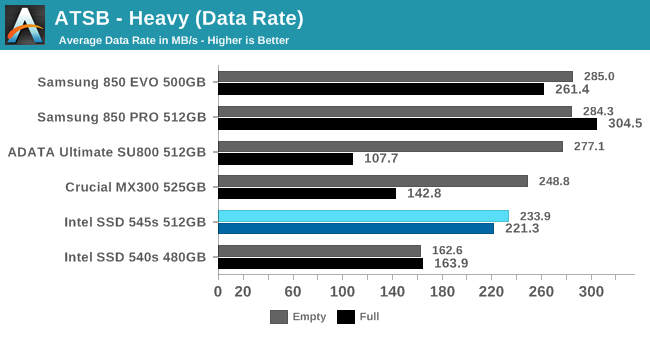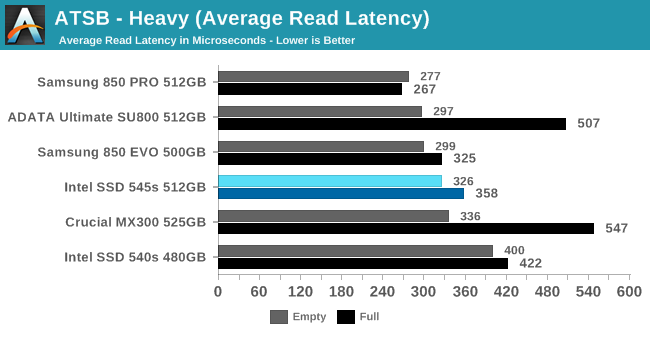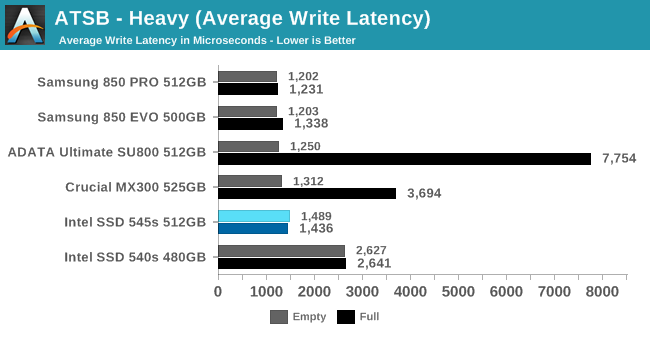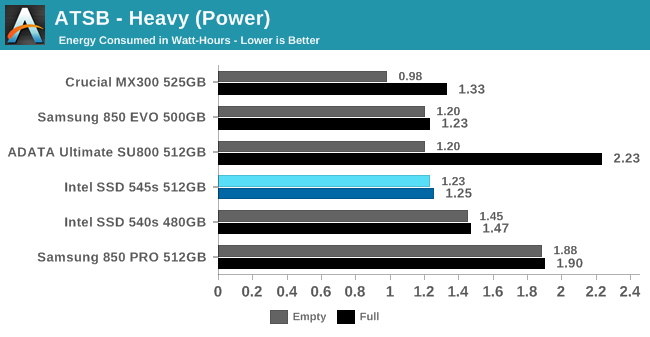The Intel SSD 545s (512GB) Review: 64-Layer 3D TLC NAND Hits Retail
by Billy Tallis on June 27, 2017 6:00 AM ESTAnandTech Storage Bench - Heavy
Our Heavy storage benchmark is proportionally more write-heavy than The Destroyer, but much shorter overall. The total writes in the Heavy test aren't enough to fill the drive, so performance never drops down to steady state. This test is far more representative of a power user's day to day usage, and is heavily influenced by the drive's peak performance. The Heavy workload test details can be found here. This test is run twice, once on a freshly erased drive and once after filling the drive with sequential writes.

The Intel SSD 545s shows substantial improvement over the 540s in average data rates for the Heavy test. The 545s is not quite able to compete against Samsung as was the case for The Destroyer, but it comes much closer than its predecessor.
The 545s also fares far better when the test is run on a full drive than the drives that use the previous generation 32L 3D TLC (ADATA's SU800 and Crucial's MX300). Both of those drives beat the 545s when the test is run on an empty drive, but suffer a huge performance loss when the drive is full.

The latency measurements for the Intel 545s on the Heavy test tell a similar story to the average data rates. Intel is now in the same league as the other 3D NAND SSD, though still in last place. When the test is run on a full drive, the Crucial and ADATA drives fall apart and average latency spikes to the 2–4ms range while the latency of the Intel 545s is unaffected and remains well below 1ms.


The read latency of the older Intel 540s is not too far behind the 3D NAND drives and it handles being full with no trouble, but its write latency in either case is almost twice as high as the 3D NAND drives. The biggest improvement of the Intel 545s comes from cutting that write latency. The read latency also improved enough to surpass the Crucial MX300.

The energy usage of the Intel 545s during the Heavy test has it essentially tied for second place with the Samsung 850 EVO, while the Crucial MX300 has the clear lead when the test is run on an empty drive. The MX300's advantage disappears when the test is run on a full drive and the SU800's energy usage almost doubles.










74 Comments
View All Comments
cybertec69 - Tuesday, June 27, 2017 - link
There is no NANDI shortage, it's all a bunch of nonsense, it's nothing more than price gouging.patrickjp93 - Wednesday, June 28, 2017 - link
Yes there is. Factories are converting all of their equipment from planar to 3D. It takes time just to move everything, then tune yields, and boost to mass production. On top of that, NAND demand has doubled in the past 2 years. There is a very real shortage.AnTech - Wednesday, June 28, 2017 - link
How does it compare to the current gold standard (Samsung Portable SSD T3)?Samsung Portable SSD T3 is so amazing that keeps cold even when booting Mac and working from it all day long. Really remarkable and amazing!
BTW, bring much larger sizes of 4 TB and more! And much cheaper prices!
Hurr Durr - Wednesday, June 28, 2017 - link
>portable ssd>gold standard
In what, waiting for the file transfer to finish?
mayankleoboy1 - Wednesday, June 28, 2017 - link
Regarding the "Random read performance" metric as outlined in http://www.anandtech.com/show/9009/ocz-vector-180-...Do you think it makes more sense to give 50%:37.5:12.5% weights to QD1:QD2:QD4 , instead of taking simple average?
Doubleslash - Wednesday, June 28, 2017 - link
Can you please do some meaningful IOPS, bandwidth and latency tests with fio or iozone? Things like sustained random 4k/8k/16k IOPS and large-block (64k/256k/512k/1024k) sequential read and write throughput are much better suited to compare wear-leveling, cache and controller performance.You can omit these SYSmark test as they are pretty useless. As the result indicates they do not stress the disk subsystem very much.
jardows2 - Wednesday, June 28, 2017 - link
Reviewing these charts, this product falls between the EVO and the MX300, but only slightly better than the MX300. It appears that the only realistic differences between the 545 and the MX300 are seen when the MX300 is full. Who uses their drives full? The current $20 price premium of the 545 over the MX300 doesn't seem worth it for the small gains, unless Intel can improve performance with some firmware updates.Wolfpup - Wednesday, June 28, 2017 - link
Wish companies would release MLC if not SLC drives too... Really not excited about being stuck with TLC.And I'm YEARS past caring about the performance of any of these drives, unless there's something weird about them. I care about reliability.
Hell, a few of my systems (not main systems, but still) boot if 5400RPM mechanical drives, and are fine. I really don't care if word launches in 0.0001 seconds or 0.0002 seconds or whatever LOL
piiman - Saturday, July 22, 2017 - link
"I really don't care if word launches in 0.0001 seconds or 0.0002 seconds or whatever LOL"Blasphemy!
alpha754293 - Thursday, June 29, 2017 - link
I look forward to seeing how it performs on the random write tests...I have four Intel 540 series 1 TB SSD drives at home and they're ok. I traded off speed for capacity and cost, and I didn't know that this was launching, so this was sort of a welcomed surprise.